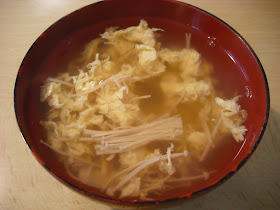I have recently bought 2.5 kg of fresh enokitake from the enokitake factory nearby, dried it all, and tried it in a number of dishes.
干しエノキタケについては以前にここで述べましたが、今日また話そうと思います。
最近、生のエノキタケを2.5キロ、近所のエノキタケ工場から買って、すべて干して、色々な料理に試してきました。
There are two ways to dry enokitake: Drying in the sun for about one day and drying in the shade for two or three days. Of course, you can dry it in a drying machine if you have one. I dried my enokitake in the sun whenever possible. Then, I put the dried enokitake in the microwave and heated it for 40-60 seconds depending on the amount to decompose flammutoxin (a type of hemolytic protein).
(As I said in a previous post, having fresh enokitake is not a good idea because it contains this protein. When heated, enokitake will do you no harm because the protein will be decomposed.)
エノキタケを干すには2つの方法があります。1日程度、日干しするか、2、3日陰干しするか。もちろん、乾燥機があれば、乾燥機で干すこともできます。私はできるだけ日干ししました。そして、干しエノキを電子レンジに入れ、量に応じて40~60秒加熱し、フラムトキシン(溶血性たんぱく質の一種)を分解しました。
(前に言ったように、生のエノキタケにはこのたんぱく質が含まれるため、生食はよくありません。加熱すると分解されるので、問題ありません。)

Some say that dried enokitake tastes like dried squid or dried shrimp. I personally don't think so, but I do like its distinctive flavor.
干しエノキタケはスルメ(干したイカ)や干し海老のような味がすると言いますが、私自身はそうは思いません。でも、その独特な味は好きです。

Clear soup:
澄まし汁:

チャーハン:
Fried rice:

Tempura (kakiage):
天ぷら(かき揚げ):

Soup for udon:
うどん用のスープ:

You can get good dashi from dried enokitake. My son said, "Umai!" when he took the first sip of the soup.
干しエノキタケからはいい出汁がでます。息子は最初にスープを飲んだときに「美味い!」と言いました。
This was such an interesting post! I read your older posts about the enokitake factory as well and was astonished that it took 4 months to grow. Here in California, I can find bunches of enokitake (wrapped nicely) for 99 cents each. It seems rather cheap for 4 months of work!
ReplyDeleteOn the subject of dried enokitake, can you eat it raw after it is dried or should you cook it? I love enokitake and sometimes there are big sales on them -- even for 50 cents a bunch. I'd be tempted to try drying them although when are you supposed to stop the drying process and do you wash the mushrooms beforehand?
YSC: First of all, I think I wrote that it took 2 months to cultivate enoki, not 4.
ReplyDeleteHere in my area, I can get enoki for about 400 yen per kg around this time of year. It can get much cheaper depending on the time of year.
Unfortunately, I can't find any reliable information as to how long enoki should be heated to decompose flammutoxin, so I can't answer your first question with confidence. Let me just say that some people like to have dried enoki (dried but not microwaved) as an appetizer for sake, etc., but I personally feel inclined to cook it for a considerable length of time, or at least 2 to 3 minutes.
You can stop the drying process anytime you think the texture is right (and keep it in the freezer). As a rough guide, enoki should be dried until it is reduced to 1/10 of its original weight. In one of my drying processes, I dried 1,060 g of enoki to 140 g.
I don't wash the enoki beforehand, but I have no idea how hygienically enokitake is cultivated in your country.
Whoops, 2 months sounds much more reasonable! The price you pay is much cheaper than what I can get here, but strangely enough, when I checked the enokitake at the local market I found that the packages come from Korea and Japan. I can't believe that they are air-flying mushrooms to sell for relatively cheap here. It makes me think hard about the cost of jet fuel and the impact on the environment.
ReplyDeleteCalifornia itself produces a lot of fruit and vegetables, but the locally grown Crimini and button mushrooms are more expensive than the imported enokitake. I don't know whether this is due to the difference in type of mushroom, but I was surprised that enokitake is not locally produced. It's not the only type of mushroom flown in either. In the last few months I've seen a sudden rise in the availability of fresh nameko, maitake, and buna shimeji, as well as other specialty mushrooms in the Japanese and Chinese markets here. They are all imported from Korea and Japan. I think there must be some supplier importing them in great quantities for the prices are relatively low.
YSC: Here in Japan, imported fruits like oranges, grapefruits, and lemons and meats like beef and pork are usually cheaper than domestically produced ones. I sometimes wonder why this is so, considering all the costs associated with transportation, but it's true.
ReplyDeleteFresh, domestically produced button mushrooms are very expensive in Japan, and crimini mushrooms are probably impossible to find in Japan. I understand that button mushrooms account for a majority (90%?) of mushroom consumption in the United States, but here in Japan, they are much less popular, and because of their high prices, I usually use imported, canned button mushrooms when I need them.
Anyway, I think drying enokitake is worth the effort, and I hope you try it some day.